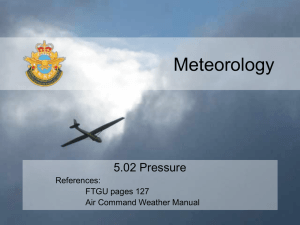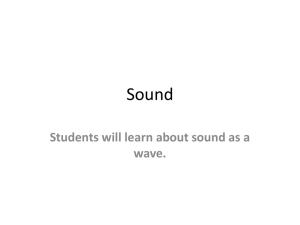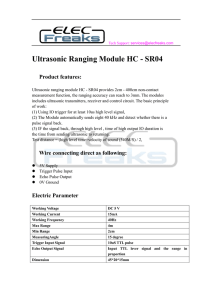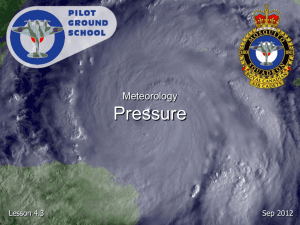THE POTENTIAL OF A SPACE ALTIMETER WHEN MEASURING SIGNIFICANT WAVE HEIGHT
advertisement
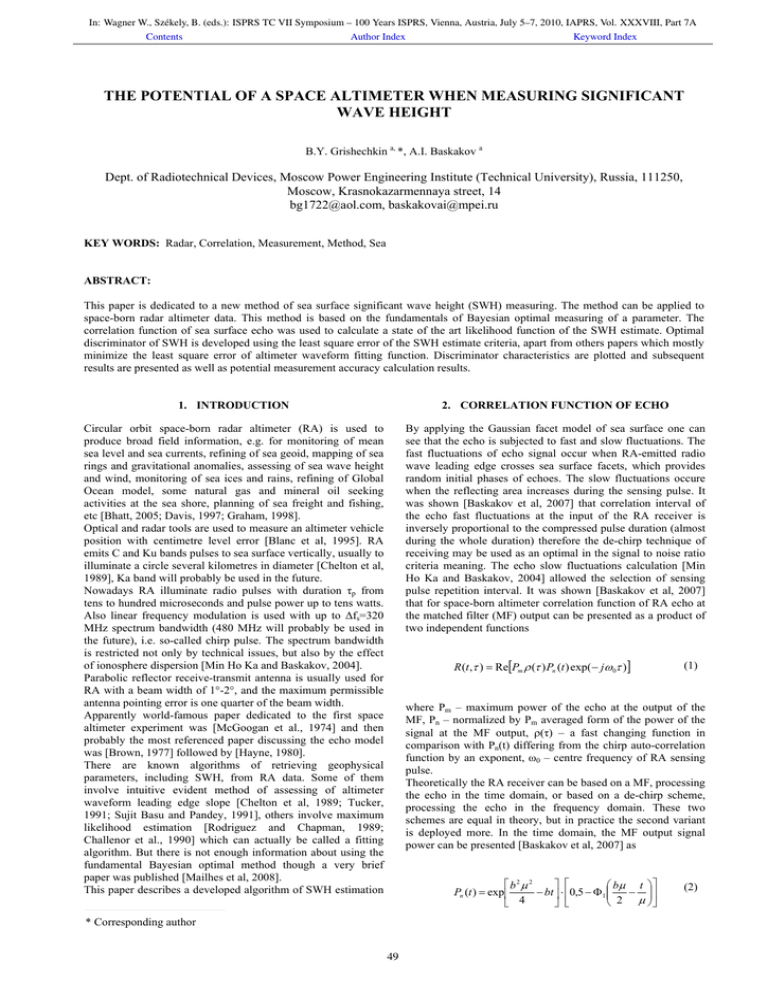
In: Wagner W., Székely, B. (eds.): ISPRS TC VII Symposium – 100 Years ISPRS, Vienna, Austria, July 5–7, 2010, IAPRS, Vol. XXXVIII, Part 7A Contents Author Index Keyword Index THE POTENTIAL OF A SPACE ALTIMETER WHEN MEASURING SIGNIFICANT WAVE HEIGHT B.Y. Grishechkin a, *, A.I. Baskakov a Dept. of Radiotechnical Devices, Moscow Power Engineering Institute (Technical University), Russia, 111250, Moscow, Krasnokazarmennaya street, 14 bg1722@aol.com, baskakovai@mpei.ru KEY WORDS: Radar, Correlation, Measurement, Method, Sea ABSTRACT: This paper is dedicated to a new method of sea surface significant wave height (SWH) measuring. The method can be applied to space-born radar altimeter data. This method is based on the fundamentals of Bayesian optimal measuring of a parameter. The correlation function of sea surface echo was used to calculate a state of the art likelihood function of the SWH estimate. Optimal discriminator of SWH is developed using the least square error of the SWH estimate criteria, apart from others papers which mostly minimize the least square error of altimeter waveform fitting function. Discriminator characteristics are plotted and subsequent results are presented as well as potential measurement accuracy calculation results. 1. INTRODUCTION 2. CORRELATION FUNCTION OF ECHO Circular orbit space-born radar altimeter (RA) is used to produce broad field information, e.g. for monitoring of mean sea level and sea currents, refining of sea geoid, mapping of sea rings and gravitational anomalies, assessing of sea wave height and wind, monitoring of sea ices and rains, refining of Global Ocean model, some natural gas and mineral oil seeking activities at the sea shore, planning of sea freight and fishing, etc [Bhatt, 2005; Davis, 1997; Graham, 1998]. Optical and radar tools are used to measure an altimeter vehicle position with centimetre level error [Blanc et al, 1995]. RA emits С and Ku bands pulses to sea surface vertically, usually to illuminate a circle several kilometres in diameter [Chelton et al, 1989], Ka band will probably be used in the future. Nowadays RA illuminate radio pulses with duration τp from tens to hundred microseconds and pulse power up to tens watts. Also linear frequency modulation is used with up to Δfs=320 MHz spectrum bandwidth (480 MHz will probably be used in the future), i.e. so-called chirp pulse. The spectrum bandwidth is restricted not only by technical issues, but also by the effect of ionosphere dispersion [Min Ho Ka and Baskakov, 2004]. Parabolic reflector receive-transmit antenna is usually used for RA with a beam width of 1°-2°, and the maximum permissible antenna pointing error is one quarter of the beam width. Apparently world-famous paper dedicated to the first space altimeter experiment was [McGoogan et al., 1974] and then probably the most referenced paper discussing the echo model was [Brown, 1977] followed by [Hayne, 1980]. There are known algorithms of retrieving geophysical parameters, including SWH, from RA data. Some of them involve intuitive evident method of assessing of altimeter waveform leading edge slope [Chelton et al, 1989; Tucker, 1991; Sujit Basu and Pandey, 1991], others involve maximum likelihood estimation [Rodriguez and Chapman, 1989; Challenor et al., 1990] which can actually be called a fitting algorithm. But there is not enough information about using the fundamental Bayesian optimal method though a very brief paper was published [Mailhes et al, 2008]. This paper describes a developed algorithm of SWH estimation for RA based on the Bayesian method. By applying the Gaussian facet model of sea surface one can see that the echo is subjected to fast and slow fluctuations. The fast fluctuations of echo signal occur when RA-emitted radio wave leading edge crosses sea surface facets, which provides random initial phases of echoes. The slow fluctuations occure when the reflecting area increases during the sensing pulse. It was shown [Baskakov et al, 2007] that correlation interval of the echo fast fluctuations at the input of the RA receiver is inversely proportional to the compressed pulse duration (almost during the whole duration) therefore the de-chirp technique of receiving may be used as an optimal in the signal to noise ratio criteria meaning. The echo slow fluctuations calculation [Min Ho Ka and Baskakov, 2004] allowed the selection of sensing pulse repetition interval. It was shown [Baskakov et al, 2007] that for space-born altimeter correlation function of RA echo at the matched filter (MF) output can be presented as a product of two independent functions R (t ,τ ) = Re[Pm ρ (τ ) Pn (t ) exp( − jω 0τ ) ] (1) where Pm – maximum power of the echo at the output of the MF, Pn – normalized by Pm averaged form of the power of the signal at the MF output, ρ(τ) – a fast changing function in comparison with Pn(t) differing from the chirp auto-correlation function by an exponent, ω0 – centre frequency of RA sensing pulse. Theoretically the RA receiver can be based on a MF, processing the echo in the time domain, or based on a de-chirp scheme, processing the echo in the frequency domain. These two schemes are equal in theory, but in practice the second variant is deployed more. In the time domain, the MF output signal power can be presented [Baskakov et al, 2007] as ⎡b2μ 2 ⎤ ⎡ ⎛ bμ t ⎞ ⎤ − bt ⎥ ⋅ ⎢0,5 − Φ1 ⎜⎜ − ⎟⎟⎥ Pn (t ) = exp ⎢ ⎝ 2 μ ⎠⎦ ⎣ 4 ⎦ ⎣ _________________________________________________________________________________________________________________________________________________________________________________________________________ * Corresponding author 49 (2) In: Wagner W., Székely, B. (eds.): ISPRS TC VII Symposium – 100 Years ISPRS, Vienna, Austria, July 5–7, 2010, IAPRS, Vol. XXXVIII, Part 7A Contents Author Index Keyword Index where b – parameter depending on the antenna beam width, antenna pointing error and sea surface roughness; μ – parameter depending to the sea surface wave height supposing that facets ordinates probability density is Gaussian and μ= 1 πΔf s 2 ⎛ 2σ ⎞ + 2⎜ z ⎟ ⎝ c ⎠ 2 4. OPTIMAL ESTIMATION A discriminator is the key unit of any tracking measuring scheme. The main task for RA is to measure its altitude. Height discriminator analysis was presented in [Baskakov, 1994] and other papers. This paper presents analysis of SWH discriminator. The output signal of an optimal (meaning the least square error of the estimated parameter) discriminator is determined by the measuring parameter derivative of the likelihood function logarithm (5). The optimal discriminator algorithm was mathematically calculated assuming that other parameters of the waveform were fixed. Then the influence of other parameters variation was assessed. Mathematically it was preferable to differentiate (5) by parameter μ (3) instead of SWH value. Parameter μ can be recalculated into standard deviation of sea surface facets ordinates σz and then into SWH as mentioned above. As well as to processing waveform in the time domain [Grishechkin et al, 2008] it can be shown that for processing in the frequency domain the discriminator characteristic has the following formula (3) c – light velocity; σz – sea surface facets standard deviation, which can be recalculated into the significant wave height (SWH) H1/3 = 4σz [Chelton, 1989; Baskakov et al, 2007]; Φ1(x)– probability integral divided by 2. When processing the echo in the frequency domain the average power spectrum of the signal at the de-chirp mixer output accounting for side lobe correction can be calculated as Fourier transform of the two-dimension correlation function (1) and after normalizing by maximum value of power spectral density Sm can be presented as [10] ⎤ ⎡ ⎛ bμ f ⎞⎤ (4) ⎥ ⋅ ⎢0,5 − Φ 1 ⎜⎜ 2 − kμ ⎟⎟⎥ ⎝ ⎠⎦ ⎦ ⎣ ⎡ b 2 μ 2 bf − S n ( f ) = exp ⎢ k ⎣ 4 ∞ U dμ (δμ ) = S m ∫ S n ( f , μ )v rμ ( f , μ + δμ )df (6) −∞ where k – frequency slope in the sensing pulse and the frequency axis f is shifted by the intermediate frequency value fint. Altimeter waveform is the average power form of the echo at the MF output as well as the average power spectrum density at the de-chirp mixer output. The vehicle height above the sea surface, SWH, sea surface backscattering coefficient σ0 and antenna pointing error relate to the offset and the shape of the waveform [Baskakov et al, 2007], therefore they can be revealed by processing the waveform. Practically the most demanding part of the process is fulfilled by on-Earth centres [Zigna et al, 2001]. where the discriminator reference function has the following formula 1 2 b ( μ + δμ ) S n ( f , μ + δμ ) − v r μ ( f , μ + δμ ) = 2 2 ⎡ 1 ⎤ + S n ( f , μ + δμ )⎥ qm ⎢ ⎣ qm ⎦ 2 2 ⎡ b (μ + δμ ) ⎤ bf ⎤ ⎡ b f − exp ⎢ ⎥ ⋅ ⎢ 2 + k (μ + δμ )2 ⎥ 4 k ⎦ ⋅ ⎣ ⎦ ⎣ − 2 ⎡ 1 ⎤ + S n ( f , μ + δμ )⎥ π qm ⎢ ⎣ qm ⎦ 3. OPTIMAL DETECTION 2 ⎡ ⎛ b (μ + δμ ) ⎞ ⎤ f − exp ⎢ − ⎜ ⎟ ⎥ 2 k (μ + δμ ) ⎠ ⎥⎦ ⎢⎣ ⎝ ⋅ 2 ⎡ 1 ⎤ π qm ⎢ + S n ( f , μ + δμ )⎥ ⎣ qm ⎦ According to the theory of statistical radio location there must be a detection process before measuring. After resolving an according Fredholm equation the logarithm of likelihood function for RA was presented in [Grishechkin and Baskakov, 2007] as Λ[ξ (t ) / τ 0 ] = C 0 − 1 T 2 ∫ ξ (t )dt + 2N 0 0 and the signal to noise ratio in the bandwidth of one filter of the spectrum processing unit corresponding to the highest point of RA waveform has the following formula (5) 2 + (7) • 1 T q (t ) ∞ ξ (τ )e jω τ h f (t − τ )dτ dt ∫ ∫ 2 N 0 0 1 + q (t ) − ∞ 0 qm = Sm N 0 ΔFc T (8) • where ξ(t) – input signal, h f (t − τ ) – pulse response characteristic of the MF, q(t) – current ratio of the echo power to the power spectral density of the RA receiver noise (N0) at the MF output, T – duration of the echo, C0 – a constant which does not depend on the echo. where ΔFc is inversely proportional to the correlation interval of the fast fluctuations mentioned above. Equations (6) and (7) were used to plot the series of discriminator characteristics, see figure 1. The characteristics are plotted as a function of δf error determined by the current altitude error. The 1 kHz step of δf corresponds to 10 cm step of 50 In: Wagner W., Székely, B. (eds.): ISPRS TC VII Symposium – 100 Years ISPRS, Vienna, Austria, July 5–7, 2010, IAPRS, Vol. XXXVIII, Part 7A Contents Author Index Keyword Index altitude. Other parameters are fixed: vehicle orbit height h = 1000 km, Δfs=320 MHz, τp=102.4 μs, qm = 20 db, true standard deviation sea surface facets ordinates σz tr = 1 m. Having (6) and (7) one can calculate the correlation function of the discriminator output signal and then calculate the spectrum of the output signal, which, at zero frequency, is equal to the standard deviation of the estimate of μ. The resulting standard deviation of the estimate of sea surface facets ordinates σz, which can be recalculated to SWH, is plotted in figure 2. U dμ (δμ) S mb 2 2. Optimal discriminator demands compensation of noise component of the discriminator output signal which can be provided by processing of RA input “signal” when there is no echo (e.g. before emitting the next pulse). 3. SWH measurements accuracy can not be reduced lower then the limit determined by the natural irreducible fluctuations of RA echo which caused by the random character of sea surface reflection. As expected, optimal discriminator for SWH estimator developed by using the Bayesian method is the most accurate of all the published. 1 2 REFERENCES 3 Baskakov A.I., 1994. Precise Space-born Oceanographic Radar Altimeter: Students Manual, Power Engineering Institute (Technical University), Moscow, Russia (in Russian). 4 5 Baskakov, A.I., Vazhenin, N.A., Morozov, K.N., 2000. Comparison of information signal processed using time- and frequency-domain methods in oceanographic precision radar altimeters. Earth Observation Remote Sensing, 16, pp. 449-455. δμ, s Baskakov, A.I., Min Ho Ka, Vazhenin, N.A, Grishechkin, B.Y., 2007. Correlation function analysis of precise space altimeter echo. Proceedings of Universities in Russia. Radio electronics, 1, pp. 53-62 (in Russian). Figure 1. Sea wave height estimator discriminator characteristic series, 1 – δf=-2 kHz; 2 – δf =-1 kHz; 3 – δf =0 kHz; 4 – δf =1 kHz; 5 – δf =2 kHz Bhatt, V., Kumar, R., Basu, S., Agarwal, V.K., 2005. Assimilation of altimeter significant wave height into a thirdgeneration global spectral wave model. IEEE Transactions on Geoscience and Remote Sensing, 43(1), pp. 110-117. σμ, ns σσz,m 1,5 1 0,5 Blanc, F., Le Traon, P.Y., Houry, S., 1995. Reducing orbit error for a better estimate of oceanic variability from satellite altimetry. Journal of Atmospheric and Oceanic Technology, 12(2), pp.150-160. 15 3 2 1 10 5 Brown, G.S., 1977. The average impulse response of a rough surface and its applications, IEEE Transactions on Antennas and Propagation, AP-25 (1), pp. 67-74. 10 Challenor, P.G., Srokosz, M.A., Tokmakian, R.T., 1990. Maximum likelihood estimation for radar altimetry, Monitoring the Sea, IEE Colloquium on 18/01/1991, pp. 10/1-10/3. 15 20 25 qm, db Chelton, D.B., Walsh, E.J., MacArthur, J.L., 1989. Pulse compression and sea level tracking in satellite altimetry. Journal of Atmospheric and Oceanic Technology, 6, pp. 407438. Figure 2. Potential accuracy of single measurement of parameters μ and σz, 1 – σz tr = 1 m; 2 – σz tr = 2 m; 3 – σz tr = 4 m Usually homogeneous sea surface roughness area is about 100 km or more, therefore it is adequate to average SWH measurements for about 4 seconds. If the pulse repetition frequency is 1 kHz and σz tr is from 1 m to 4 m and signal to noise is 20 db then averaging for 4 s can provide less than 1 cm error of σz measurement, i.e. 4 cm error for SWH. Davis, C.H., 1997. A robust threshold retracking algorithm for measuring ice-sheet surface elevation change from satellite radar altimeters. Geoscience and Remote Sensing, IEEE Transactions, 35(4), pp. 974 – 979. 5. CONCLUSION Graham, D., 1998. Determination of oceanic rain rate and rain cell structure from altimeter waveform data. Part I: Theory. Journal of atmospheric and oceanic technology, 15, pp. 13611378. This paper and our previous papers reach the following conclusions: 1. Systematic error of optimal RA discriminators for SWH measurements depends on altimeter altitude error. Grishechkin, B.Y., Baskakov, A.I., 2007. Echo detection characteristics of precise space born oceanographic radar altimeter. Aerospace Devices Engineering, 5, pp. 37-40 (in Russian). 51 In: Wagner W., Székely, B. (eds.): ISPRS TC VII Symposium – 100 Years ISPRS, Vienna, Austria, July 5–7, 2010, IAPRS, Vol. XXXVIII, Part 7A Contents Author Index Keyword Index Grishechkin, B.Y., Terehov, V.A., Baskakov, A.I., 2008. Analysis of systematic errors of optimal discriminator for sea wave heights measurements from space. Radiotechnical copybooks, 37, pp. 62-65 (in Russian). Hayne, G.S., 1980. Radar altimeter mean return waveform from near-normal-incidence ocean surface scattering. IEEE Transaction on Antennas and Propagation, AP-28 (5), pp.687692. Mailhes, C., Tourneret, J.-Y., Severini, J, Thibaut, P., 2008. Bayesian estimation of altimeter echo parameters, IEEE Internation Geoscience and Remote Sensing Symposium (IGARSS), Boston, USA. McGoogan, J.T. Miller, L.S. Brown, G.S. Hayne, G.S., 1974. The S-193 radar altimeter experiment. Proceedings of the IEEE, 62(6), pp. 793-803. Min Ho Ka, Baskakov, A.I., 2004. Restriction on the bandwidth of radio signals of a space-born precision radar altimeter due to the influence of the ionosphere. IEICE Transactions on Fundamentals of Electronics, Communications and Computer Sciences, E87-A(6), pp.1318-1322. Rodriguez, E., Chapman, B., 1989. Extracting ocean surface information from altimeter returns: the deconvolution method. Journal of Geophysical Research, 94 (C7), pp. 9761-9778. Sujit Basu, Pandey, P. C., 1991. Numerical experiment with modelled return echo of a satellite altimeter from a rough ocean surface and a simple iterative algorithm for the estimation of significant wave height, Proc. Indian Acad. Sci. (Earth Planet. Sci), 100 (2), pp.155-163. Tucker, M.J., 1991. Waves in ocean engineering, Measurement, Analysis, Interpretation. Ellis Horwood, Chichester, UK. Zigna, JM., 2009. Poseidon 2 level 1.0 processing, http://podaac.jpl.nasa.gov/jason/documents/POS2_level10.pdf (accessed 22 Feb. 2010). 52


